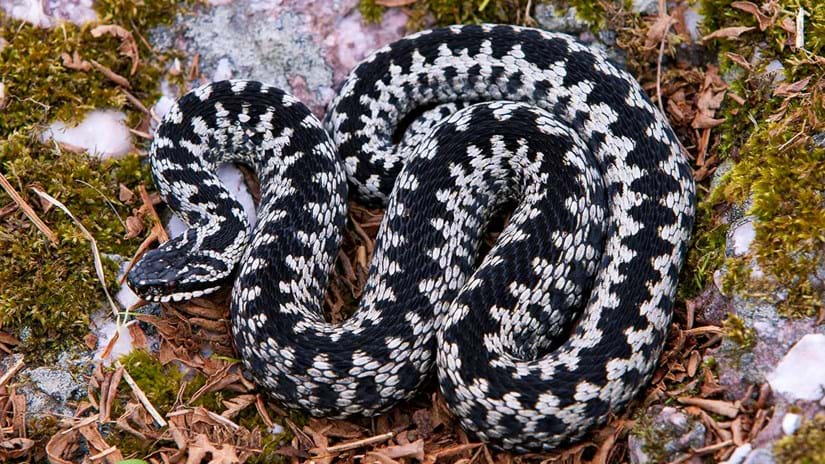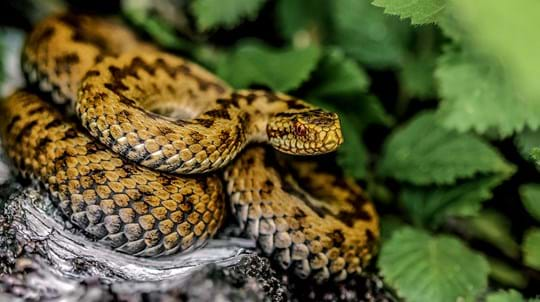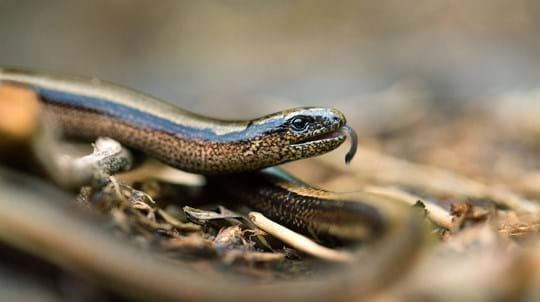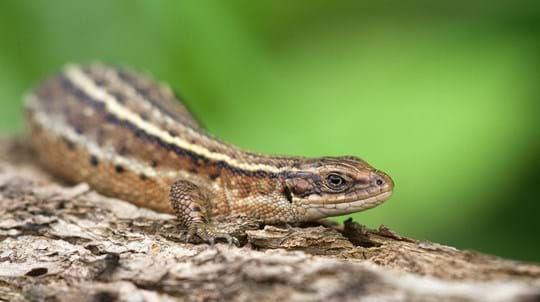
Grass snake or adder? How to tell the difference between UK reptiles
Karen Hornigold • 01 Feb 2018
Discover more about our common native reptiles and where you can find them with this snakes and lizards guide.
Read our ID tipsStealthy slitherers. Grass snakes are lethal hunters of frogs, toads and other small creatures, but will rush for cover at the first sound of humans approaching.
Common names: grass snake, barred grass snake
Scientific name: Natrix helvetica
Family: Colubridae
Habitat: wetland, woodland, farmland, grassland
Diet: amphibians, fish, small mammals, birds.
Predators: birds of prey, herons, mammalian carnivores
Origin: native
Britain’s longest snake, grass snakes can exceed a metre in length. The species is typically grey-green in colour. It has a distinctive yellow and black collar around the neck and black markings along the length of the body.
Not to be confused with: the adder, which has a distinctive dark zigzag pattern along its back. Another possible confusion species is the slow worm. These legless lizards can be identified by their shiny appearance and bullet-shaped head.

Karen Hornigold • 01 Feb 2018
Discover more about our common native reptiles and where you can find them with this snakes and lizards guide.
Read our ID tipsGrass snakes have a number of tactics to try to deter predators. These include hissing, releasing a foul-smelling secretion and playing dead.
Frogs, toads and newts are a grass snake’s favoured prey, but they will also take fish, small mammals and birds. With no venom, grass snakes rely on the element of surprise to hunt. A snake will strike out and grab its unsuspecting prey, swallowing it whole. Often, the prey is still alive when swallowed.

Credit: Mike Wilkes / naturepl.com
Grass snakes are the UK’s only egg-laying snake. Eggs are normally laid in a sheltered location within rotting vegetation. Compost heaps are often a favoured spot. Up to 40 eggs may be laid, hatching in late summer or early autumn. Only a minority of the young will reach adulthood, with many falling prey to predators such as herons, birds of prey, pheasants and even hedgehogs.
As cold-blooded reptiles, grass snakes spend the coldest part of the year in hibernation. A variety of hibernation sites may be used, provided they are warm and humid. Tree root systems, fallen trees, compost heaps and rabbit warrens are some of the places that may be utilised. Snakes will normally begin to hibernate in October or November, emerging in March or April.

Credit: David J Slater / Alamy Stock Photo
Grass snakes are found across most of England and Wales, but are absent from Scotland and Ireland. The species can occur in a variety of habitats, including woodland, but is normally found close to water. It may even occur in gardens with ponds and plenty of vegetation.
Even when threatened, grass snakes rarely bite, but may strike out with their head, keeping the mouth closed.
Grass snakes are shy creatures and will quickly retreat into cover after detecting a human. Your best chance of seeing one is to visit a suitable habitat early in the morning. This is when the snakes have to bask in the sun to generate warmth. If you disturb a snake, it’s worth quietly revisiting the spot as the same basking points are often used regularly.

Credit: Anne Marie Kalus / WTML
In 2017, the grass snakes found in Britain and western Europe were reclassified as a new species (Natrix helvetica) to separate them from those in central and eastern Europe (Natrix natrix).
There is a lack of reliable information concerning the population trend of grass snakes in the UK. However, the species is fully protected by law, meaning it is illegal to deliberately kill or harm the snakes.

Trees woods and wildlife
The adder is the UK's only venomous snake, but it's incredibly shy of people. Discover its little known mating rituals, unusual facts, folklore and more.

Trees woods and wildlife
Discover the slow worm, a legless lizard which resembles a snake. Find out what it eats, where it lives and how it breeds.

Trees woods and wildlife
The common lizard is a speedy little fella, often seen basking in the sun. Find out how to spot it, what it eats and how it breeds.